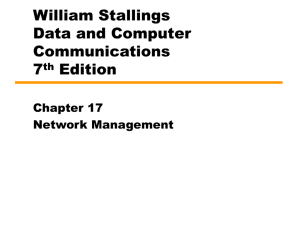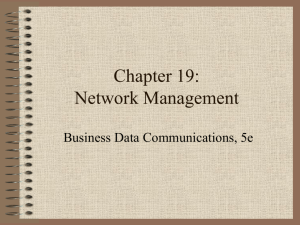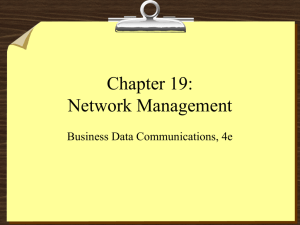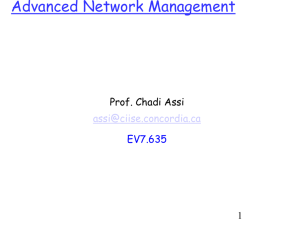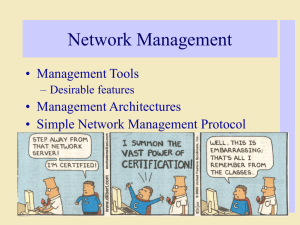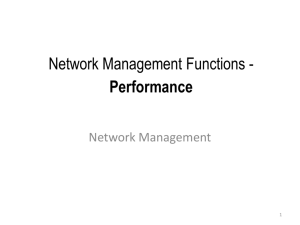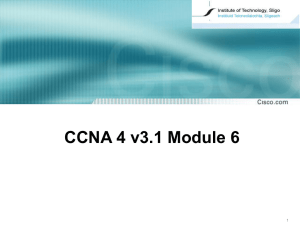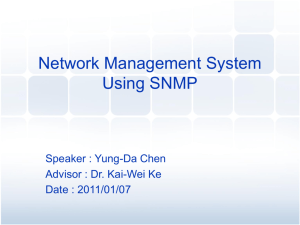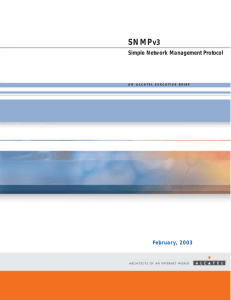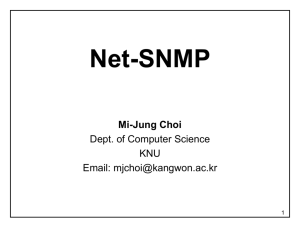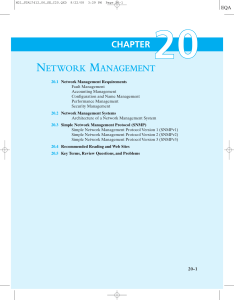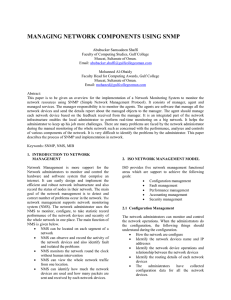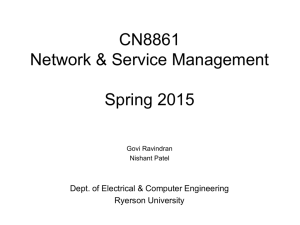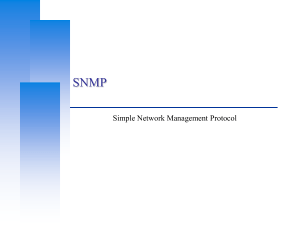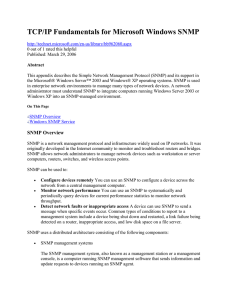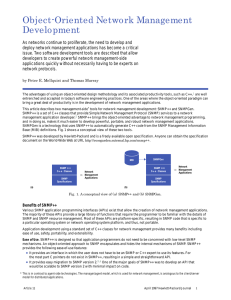Chapter 17 Network Management
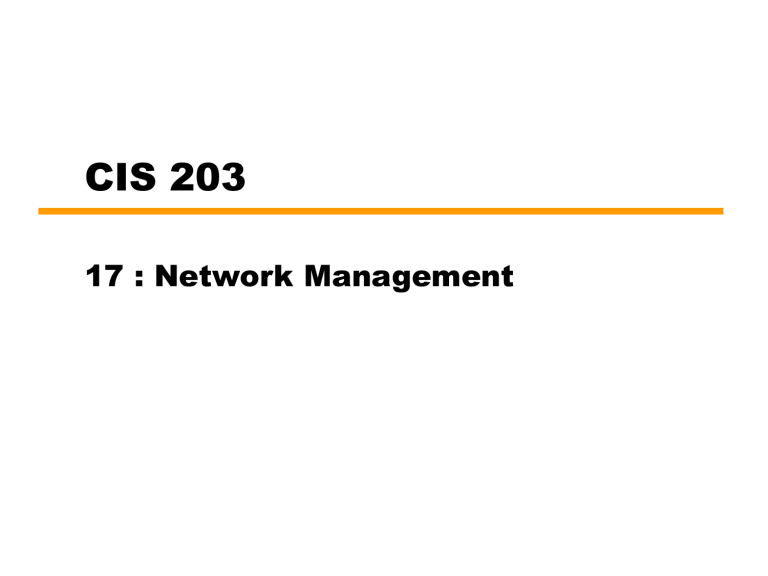
CIS 203
17 : Network Management
Introduction
• Network, associated resources and distributed applications indispensable
• Complex systems
— More things can go wrong
• Requires automated network management tools
• Need comprehensive data gathering and control tools
• SNMP
Elements of Network
Management
• Fault
• Accounting
• Configuration
• Performance
• Security
Fault Management Overview
• When fault occurs
— Determine where
— Isolate rest of network so it can continue to function
— Reconfigure or modify network to minimize impact of operation without failed components
— Repair or replace failed components
• Fault is abnormal condition that requires action to repair
— Errors (e.g. single bit error on line) occur and are not faults
Fault Management User
Requirements
• Fast and reliable problem resolution
• Immediate notification
• Impact and duration minimized by redundant components and routes
— Fault tolerance
• Fault management capability should be redundant
• After correction, fault management must ensure problem is truly resolved and no new problems introduced
— Problem tracking and control
• Minimal effect on network performance
Accounting Management
Overview
• Individual cost centers or projects charged for use of network services
• Network manager needs to be able to track use of network
— User or group may be abusing access
— Users may be making inefficient use of network
— Need to plan for network growth
Accounting Management
User Requirements
• Needs to specify sort of accounting information recorded at various nodes
— Interval between successive sendings of information
— Algorithms used in calculating charges
— Accounting reports under network manager control
• Verify users' authorization to access and manipulate accounting information
Configuration and Name
Management Overview
• Choose appropriate software and attributes and values (e.g., a transport layer retransmission timer) for device depending on function(s)
• Initializing network and gracefully shutting down
• Maintaining, adding, and updating relationships among components
• Status of components during network operation
Configuration and Name
Management User Requirements
• Startup and shutdown
• Unattended
• Need to identify components of network and connectivity
• Define and modify default attributes
• Load predefined attributes
• Change connectivity
• Reconfiguration
• Status information and notification of changes
• Routine or request driven reports
• Authorized users (operators) only to manage and control operation (e.g., software distribution and updating)
Performance Management
Overview
• Monitoring
— Tracks activities
— What is the level of capacity utilization?
— Is there excessive traffic?
— Has throughput been reduced to unacceptable levels?
— Are there bottlenecks?
— Is response time increasing?
• Controlling
— Make adjustments to improve performance
• Identify resources to be monitored
— Metrics and values for resources
Performance Management
User Requirements
• Must be known in sufficient detail to assess user queries
— Applications need consistently good response time
• Performance statistics help planning, management and maintenance
— Recognize potential bottlenecks before they cause problems
— Capacity planning based on performance information
Security Management
Overview
• Generating, distributing, and storing encryption keys
• Passwords and access control information maintained and distributed
• Monitoring and controlling access
• Logging
— Collection, storage, and examination of audit records and security logs
Security Management
User Requirements
• Facilities available for authorized users only
• Users want to know proper security in force and effective
• Management of security facilities is secure
Network Management Systems
• Collection of tools for network management
• Single operator interface
• Powerful, user friendly command set
• Performing most or all management tasks
• Minimal amount of separate equipment
— i.e. use existing equipment
• View entire network as unified architecture
• Active elements provide regular feedback
Key Elements
• Management station or manager
• Agent
• Management information base
• Network management protocol
Figure 17.1 Elements of a
Network Management System
Management Station
• Stand alone system or part of shared system
• Interface for human network manager
• Set of management applications
— Data analysis
— Fault recovery
• Interface to monitor and control network
• Translate manager’s requirements into monitoring and control of remote elements
• Data base of network management information extracted from managed entities
Management Agent
• Hosts, bridges, hubs, routers equipped with agent software
• Allow them to be managed from management station
• Respond to requests for information
• Respond to requests for action
• Asynchronously supply unsolicited information
Management Information Base
• MIB
• Representation of network resources as objects
• Each object a variable representing one aspect of managed object
• MIB is collection of access points at agent for management of station
• Objects standardized across class of system
— Bridge, router etc.
Network Management Protocol
• Link between management station and agent
• TCP/IP uses SNMP
• OSI uses Common Management Information
Protocol (CMIP)
• SNMPv2 (enhanced SNMP) for OSI and TCP/IP
Protocol Capabilities
• Get
• Set
• Notify
Management Layout
• May be centralized in simple network
• May be distributed in large, complex network
— Multiple management servers
— Each manages pool of agents
— Management may be delegated to intermediate manager
Figure 17.2 Example Distributed
Network Management Configuration
Network Management Protocol
Architecture
• Application-level protocol
• Part of TCP/IP protocol suite
• Runs over UDP
• From management station, three types of SNMP messages issued
— GetRequest, GetNextRequest, and SetRequest
— Port 161
• Agent replies with GetResponse
• Agent may issue trap message in response to event that affects MIB and underlying managed
— Port 162
SNMP v1
• August 1988 SNMP specification issued
• Stand alone management stations and bridges, routers workstations etc supplied with agents
• Defines limited, easily implemented MIB of scalar variables and two dimensional tables
• Streamlined protocol
• Limited functionality
• Lack of security
• SNMP v2 1993, revised 1996
— RFC 1901-1908
Figure 17.3 SNMPv1
Configuration
Figure 17.4 The Role of
SNMPv1
SNMP v2 (1)
• Framework on which network management applications can be built
— e.g fault management, performance monitoring, accounting
• Protocol used to exchange management information
• Each player maintains local MIB
— Structure defined in standard
• At least one system responsible for management
— Houses management applications
SNPM v2 (2)
• Support central or distributed management
• In distributes system, some elements operate as manager and agent
• Exchanges use SNMP v2 protocol
— Simple request/response protocol
— Typically uses UDP
• Ongoing reliable connection not required
• Reduces management overhead
Figure 17.5 SNMPv2 Managed
Configuration
Structure of
Management Information
• SMI
• Defines general framework with which MIB defined and constructed
• Identifies data types
• How resources are represented and named
• Encourages simplicity and extensibility
• Scalars and two dimensional arrays of scalars
(tables) only
Protocol Operation
• Exchange of messages
• Outer message header deals with security
• Seven types of PDU
SNMP v3
• Addresses security issues of SNMP v1/2
• RFC 2570-2575
• Proposed standard January 1998
• Defines overall architecture and security capability
• To be used with SNMP v2
SNMP v3 Services
• Authentication
— Part of User-Based Security (UBS)
— Assures that message:
• Came from identified source
• Has not been altered
• Has not been delayed or replayed
• Privacy
— Encrypted messages using DES
• Access control
— Can configure agents to provide a number of levels of access to
MIB
— Access to information
— Limit operations
Required Reading
• Stallings chapter 17
• Loads of web sites on SNMP
